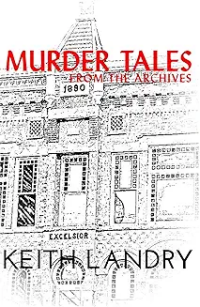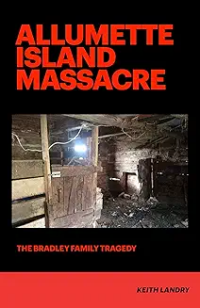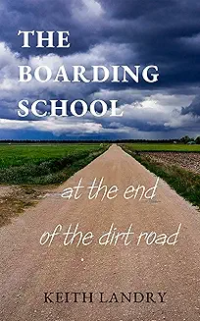 Keith Landry - guest on August 2024
Keith Landry - guest on August 2024
Keith has authored more than 20 books, showcasing his prolific and diverse storytelling prowess. His fast-paced narrative style captivates readers, drawing them into immersive worlds that delve into complex relationships and personal growth. Camilla Hillberg
Here is some praise for Keith Landry’s books
“Keith Landry takes us back in time by skillfully using newspaper reports of the day. Landry showcases the brilliant writing of Canadian newspaper men (I believe all the reporters were men, as were all the police, lawyers, jurists and other authority figures).?Building on the bare bones reporting that might please even Ernest Hemmingway, Landry brings us to a world where men totally dominated every aspect of Canadian life. The first story takes us back to the turn of the last century, long before women could even vote.”
“A trip down a chilling memory lane with original accounts by Ottawa Valley reporters writing about heinous murders many decades ago.”
“I love all his books, so well researched and spell binding. I like how he intertwined a love story into the script. How about making this into a movie or theatre production?”
“Living in Saskatchewan, I have heard about “Black Tuesday” off and on for years, but never actually had a vivid “picture” of what took place. This book is definitely a vivid portrait of dismal treatment of the miners, their insurrection and the horrific events of September 29, 1931. I now have mental images of that sad and horrific day.”
“I loved this book. It gives the reader an uncomfortable look at the Prairies in the 1930’s. Uncomfortable because we learn how poorly Canadians were treated by companies... not something that we want to be reminded of or made aware of for the first time. The mistreatment that the miners experienced at the hands of the mine owners and operators was soften by the narrative of the love story.?The author has well researched the events of the time. The history of rural Saskatchewan and the developing relationship between a local women and wealthy oil man from Calgary keeps us turning the pages.”
“Master storyteller Keith Landry has done it again. His innate ability to lay words down on paper as if his pen and paper are brush and canvas, shines through in this compilation of Canadian Catastrophes.?Mr. Landry’s amicable modus operandi offers the reader an opportunity to travel back in time while enjoying, an adventurous excursion, criss-crossing Canada.?Easy reading at its best.”?“This is a story I read about in a local paper and could not wait to read. I had always heard a story that there was a man hanged in the jail in my home town. This was the story. Growing up in this area nobody ever talked to me about the details. Landry’s writing style brings the reader into the small towns in an historical journey. He brings life to the central characters - the accused, the investigators and their families. A must read for anybody interested in true historical crimes, especially if you’re from the Ottawa Valley.”
“I am from the small town where this story happened! I remember my late grandfather telling me stories about this massacre! This is an easy read, Keith was able to take me to this place and visualize everything that was happening. Great detail! Keep up the great work! I’ve ordered 3 more of Keith Landry’s books!”
Keith Landry books Murder Tales in the Ottawa Valley
Murder Tales in the Ottawa Valley
SPELL BINDING, HAUNTING, INTRIGUING
Murder tales in the Ottawa Valley written by articulate and passionate newsmen from yesteryears buried for years in old newspapers are resurrected in Keith Landry’s most recent True Crime book.
There are six murder stories, the oldest in 1879 and the most recent in 1971.
Murders happened in Shawville, Ottawa, Smith Falls, Pembroke, Eganville and Winchester.
Readers are able to pretend to be a juror and learn the evidence against the accused as if they were in attendance at trials.
“Justice requires that to lawfully constituted Authority there be given that respect and obedience which is its due; that the laws which are made shall be in wise conformity with the common good; and that, as a matter of conscience all men shall render obedience to these laws.”
Buy on Amazon
 Murder Tales From the Archives
Murder Tales From the Archives
Eight true crimes stories written by anonymous newsmen from early to mid 20th century in Canadian daily newspapers, historically retold (and in parts imagined) in this book.
The first story is about the murder of a young university student during the Christmas season in Montreal. His half-brother, a Catholic Priest, is the accused.
A Saskatchewan farmer is afflicted by periods of dark moods. He murders his stepson during one of these. Whilst in prison, serving a life sentence, he strikes out at the Deputy Warden, killing him.
A man and his wife immigrate to Canada from Germany. His wife dies mysteriously. The man remarries, and his supposed second wife suffers the same fate. However, another German woman presents herself to the police and declares herself as his second wife. The man goes on for many years remarrying without divorcing previous wives. One more goes missing, never to be found.
The fourth story occurs on an army base in Saskatchewan. A young trooper puts a knife into the back of a fellow mate. The killing is over a young school teacher.
The young French student crosses the Atlantic Ocean to journey from Montreal to the Yukon to retrace his grandfather’s travels during the Klondike gold rush. He is murdered near Whitehorse.
Two cars speed by another on the Trans-Canada Highway just outside Ottawa while the car being passed was beginning to swing left. The driver of the passed car explodes into rage and chases the other two cars. The incident results in the death of two men and the near murder of their wives.
A serial killer is found innocent for his first murder. He goes on to kill four more children before he is removed from society.
The final story is about the killing of a very elderly woman in Manitoba for she and husbands pension savings.
Buy on Amazon Dalpe's Crime Chronicles 1924-1936
Dalpe's Crime Chronicles 1924-1936
Detective J. P. Dalpe, later promoted to Sergeant Detective, is assigned in the early 1920s to a special detective squad of the Quebec Provincial Police to fight crime in Hull, Quebec. The crime was so rampant in the 1920s and 30s that the New York Times called Hull "Little Chicago."
Dalpe's first major homicide investigation is the death of a man known in the St. Pierre de Wakefield area as the Hermit. The mutilated body is discovered in the dirt cellar of his small isolated cabin. Whilst this investigation is being pursued, Dalpe is sent south of Montreal to solve the murder of a man whose body is found at a town's nuisance grounds. He tracks down the murderer in Vermont and brings him back to Quebec to face justice.
Dalpe is later called upon to investigate the suspicious poisoning of a young woman in the village of Maniwaki. He suspects the sister has a hand in the death. This investigation is followed by the shooting of a man by his nephew in the same region of Quebec.
With the end of the Roaring Twenties and the arrival of the Great Depression in the 30s, Dalpe is called upon to solve one of the most heinous crimes to have ever occurred in Hull. An unemployed lumberjack is brutally beaten to death in the bush off Aylmer Road on the outskirts of Hull. Dalpe needs to coordinate the investigation with the Hull City Police Force and the Ottawa Police Force to track down suspects. He learns that organized crime is behind the murder.
The last case of Dalpe's distinguished career involves many men who are engaged in treachery, robbery, and murder. A young bank clerk is murdered while he is carrying a large sum of money from the Hull bank where he is employed to an Ottawa clearinghouse. Dalpe, as the senior officer in Hull, is once again brought into a case that is followed by Canadians across the country. He must demonstrate much tact when his boss in Montreal, Chief Detective Jargaille pushes Dalpe to the background and assumes the lead detective role in the case.
Buy on Amazon
 Allumette Island Massacre
Allumette Island Massacre
The people in Pontiac County of West Quebec have handed the oral story of Michael Bradley killing of five members of his family on a July morning in 1933 down from generation to generation. By researching newspaper accounts from the reporting of the discovery of the slain bodies, to the investigation, to his arrest and to the trials and finally his hanging in Campbell’s Bay on April 5, 1935, Keith Landry has written the detailed story in such a way that the reader feels they are in real time.
Detective Sergeant JP Dalpe, the lead detective in the investigation, is a dominant character in more of Landry’s crime books. These books are Dalpe’s Crime Chronicles and Dalpe and the Nazi. During the late winter of 2021, Keith will publish Dalpe and the Communist Spies.
This is a revision of the original story published in the book Allumette Island Massacre and Three Other Canadian Crime Stories. the original book is no longer being printed.
Buy on Amazon
 The Boarding School - at the end of the dirt road
The Boarding School - at the end of the dirt road
A father sends his two teenage boys to a boarding school in Saskatchewan after their mom dies. The brothers must readjust to a more arduous and demanding lifestyle.
Mike, the older brother, is a ‘nervous nelly’ who desperately tries to fit in. In addition, he believes he must protect his younger brother who will never fit in and who never tries to do so.
Clifford is a geek with a strong independent streak. He does not concern himself with social graces. He is more interested in discovering the mysteries of the world.
Mike was created to portray the author’s own year at a Saskatchewan boarding school complete with his private fears and challenges. His personal endeavours to fit in and take advantage of the opportunities the school offered are recalled. He feared bucking the school’s Old Boy system and standing up to those who exploited it for their own comfort and feelings of superiority. The physical intimidation caused him and the other New Boys great consternation.
Clifford, the younger brother, establishes that being tough does not mean being physically tougher than others. He is a fierce-minded new boy. He has the fortitude to be himself and face the school’s hardships. He adapts to life there and grows into his own. The author created Clifford to reveal how he wished he would have responded and used his voice to stand up for himself and others.
When the author returned home to Ottawa, he never wanted to visit Saskatchewan again. After three years of pondering his reasons for being, he returned to Saskatchewan where he met his future wife, stayed, and raised a family. Over the years, opportunities arose to return to Ottawa; those opportunities were declined. The author explains, “I turned these down. I recognized I would miss the beauty of the vast open prairie, the living skies, and the brisk weather. My friends are here. Saskatchewan is where I will rest in peace.”
The book recreates various events, locales, and conversations from memories of a year at Athol Murray’s Notre Dame College at Wilcox, Saskatchewan. The characters are products of the author’s imagination and used fictitiously. All character names and nicknames are made up to protect the innocent and not-so-innocent.
